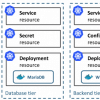Related Content
 |
Using Kubernetes Helm Charts for Increased DevOps Collaboration A Docker image is usually designed for a baseline functionality and can then be customized. However, customized resource definitions are typically not shared among other users who might have a similar application requirement. Here’s where Helm charts for Kubernetes can help reduce rework and increase collaboration. |
|
 |
How to Get Security Groups to Join Your DevSecOps Journey DevSecOps shifts security practices left and assures earlier that your application isn't vulnerable to breaches. But convincing a security group to get on board with your DevSecOps journey may not be an easy task. These four points can help you prove to your security group that DevSecOps is in everyone’s best interest. |
|
|
|
Why Use Kubernetes for Your Container Management? Kubernetes is the most commonly used open source orchestration framework for containers. It’s used for automating deployment, scaling, and management of application containers and works with many container tools, including Docker. But what makes Kubernetes so popular? And would it be useful to you? Let's take a look. |
|
 |
5 Ways to Shift Performance Testing Left Performance testing is often a barrier to accelerating software delivery. Because you need a production-like environment, performance testing often waits until the entire application is complete. But you shouldn't wait until then to get started. You can begin testing earlier to reduce rework and address issues sooner. |
|
 |
How DevOps Has Changed the Landscape of Testing The focus on automation and “continuous everything,” from integration, deployment, and now all the buzz about continuous testing, makes the daily activities of a tester in DevOps challenging. Testers may be used to controlling quality—or thinking they do—but they need to pivot to assuring their teams focus on quality. |
|
 |
Continuous Testing, Shifting Left, and Test Automation: Getting It Straight Continuous testing can help you achieve the optimal balance between speed and risk and deliver high-quality products faster. But what exactly does continuous testing entail? Is it just shifting testing left in a DevOps environment? And where does automation fit in? Here's a breakdown of all these testing concepts. |
|
 |
Is Everything Code? As modern software processes become automated, one might argue that nearly everything in software development is code. Obviously, our software applications are comprised of code, but that’s only the start of it. Our tests, delivery orchestration, and someday even our software production could be automated. |
|
 |
DevOps Isn’t Just about Releasing Faster When organizations start moving to DevOps, one of the first things they focus on is automation. It makes sense: Automated deployment tools are easy to explain, and implementing them usually shows value right away. But speed isn’t the only (or even the best) reason to move to DevOps and an automated release pipeline. |






